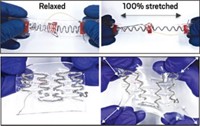Advertisement
Grab your lab coat. Let's get started
Welcome!
Welcome!
Create an account below to get 6 C&EN articles per month, receive newsletters and more - all free.
It seems this is your first time logging in online. Please enter the following information to continue.
As an ACS member you automatically get access to this site. All we need is few more details to create your reading experience.
Not you? Sign in with a different account.
Not you? Sign in with a different account.
ERROR 1
ERROR 1
ERROR 2
ERROR 2
ERROR 2
ERROR 2
ERROR 2
Password and Confirm password must match.
If you have an ACS member number, please enter it here so we can link this account to your membership. (optional)
ERROR 2
ACS values your privacy. By submitting your information, you are gaining access to C&EN and subscribing to our weekly newsletter. We use the information you provide to make your reading experience better, and we will never sell your data to third party members.
Materials
Fabricating Biocompatible Electronics That Can Last
Medical Devices: Flexible silicon circuits combine performance and durability for medical implants and prosthetics
by Katherine Bourzac
May 7, 2013

Sophisticated medical implants, such as better prosthetics to restore sight to people with damaged retinas, will require electronics with a lot of computing power. But the powerful silicon circuits found in computers and cell phones are rigid and not compatible with the squishy, delicate tissues of the body. Most efforts to make silicon circuits flexible have led to poor performance and durability.
Now researchers have developed a method for transferring complete silicon circuits onto a flexible material and encasing them in durable, biocompatible polymers (ACS Nano, DOI: 10.1021/nn401246y). The high-performance circuits work when implanted under the skin of rodents and should last for at least two years inside the body, the researchers say.
Today’s implanted medical devices isolate circuits, batteries, and other electronics in mechanically stiff casings and have limited computing power. Researchers working on biocompatible electronics are developing materials for more powerful circuits that might sit directly on the surface of an organ like the heart or the eye.
Other groups have created flexible silicon electronics by transferring one transistor at a time from silicon wafers to plastic sheets. They then connect the transistors together into complex circuits. However, using this approach is not feasible for fabricating implantable high-performance processors, which require millions or even billions of integrated transistors lined up perfectly, says Keon Jae Lee at the Korea Advanced Institute of Science and Technology.
Lee’s team came up with a solution in which they first fabricated complete circuits made from silicon using conventional chip manufacturing techniques. Then they transferred thin slices of the circuit onto a bendable piece of polymer. His lab had previously used this method to make flexible memory devices.

In the current study, they worked with radio frequency circuits, similar to those used for telecommunications and sound processing in cell phones. These circuits could be used to transmit signals into and out of the body from implanted devices that monitor for signs of disease, release drugs, or help process sensory information.
To increase the circuits’ lifetime when implanted inside a body, the researchers encased the processors in liquid-crystal polymers. These materials absorb much less water than the typical polymers used for flexible circuits.
The researchers subjected the encased radio frequency circuits to a battery of durability tests. After 1,000 cycles of bending, the 100-μm-thick circuits remained intact. The team implanted the circuits under the skin of rats for six weeks. The circuits could be switched on and off the entire time. And the liquid-crystal polymer casing showed no signs of leaking after soaking the circuits in a buffer solution at three different temperatures: 75, 85, and 95 °C. These high temperatures were meant to simulate being at human body temperature for years.
Such durability means these circuits could be used for medical implants intended to stay inside the body long term. Previous flexible circuits have been designed for more transient uses, such as taking electrical readings from the heart.
The technique is suited for applications that require a lot of data processing and therefore high-density electronics, says John A. Rogers, a materials scientist at the University of Illinois, Urbana-Champaign. Lee’s devices will complement the kinds of flexible electronics that Rogers is working on for other medical applications.





Join the conversation
Contact the reporter
Submit a Letter to the Editor for publication
Engage with us on Twitter